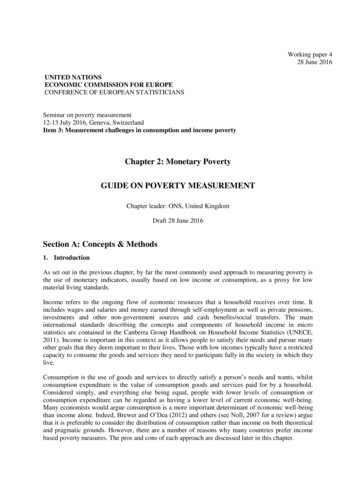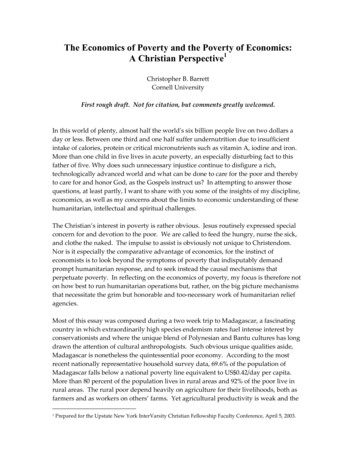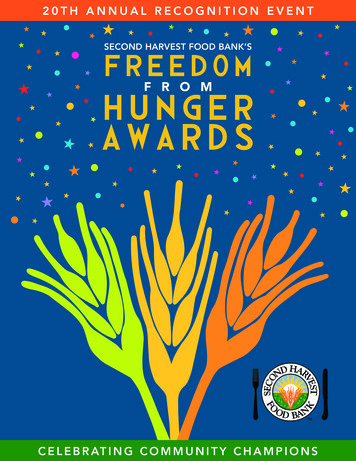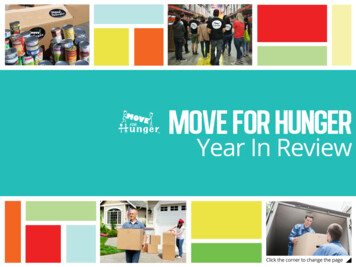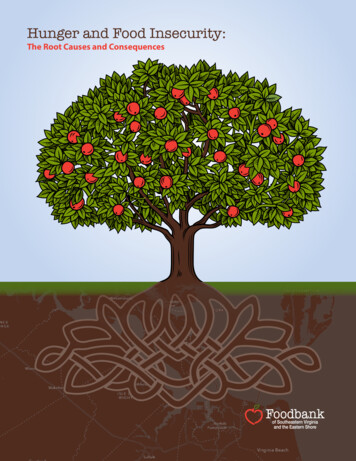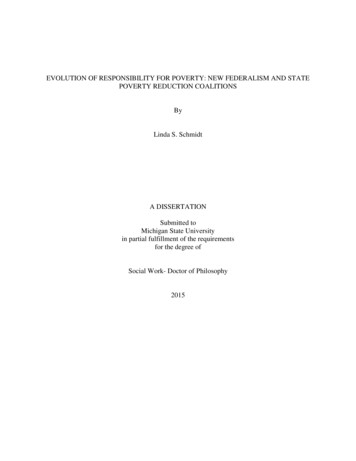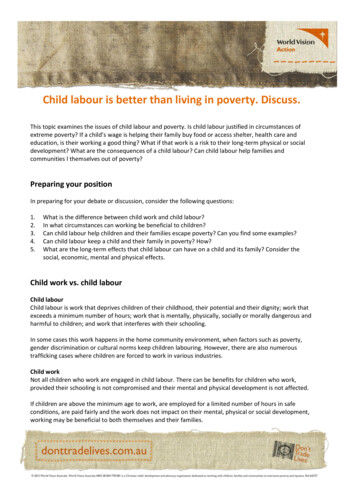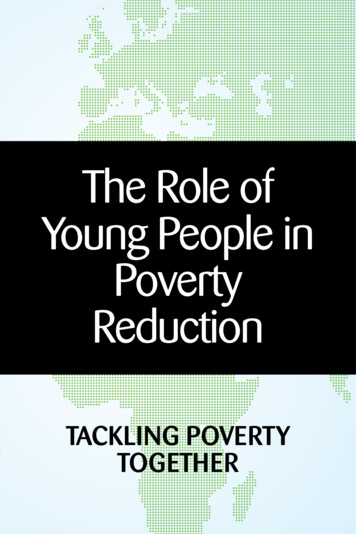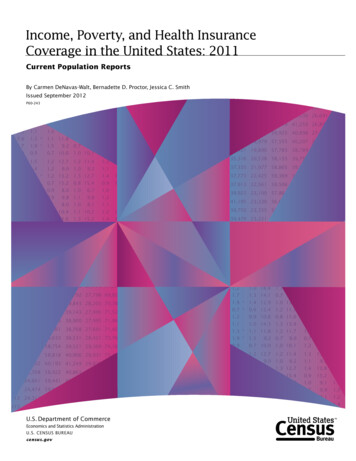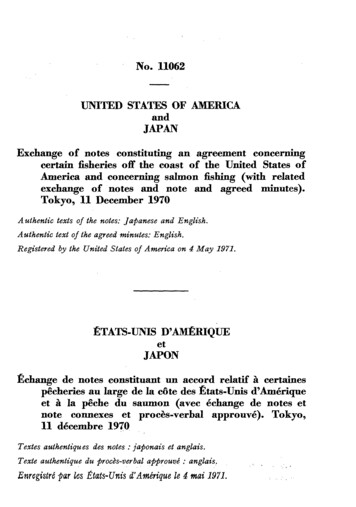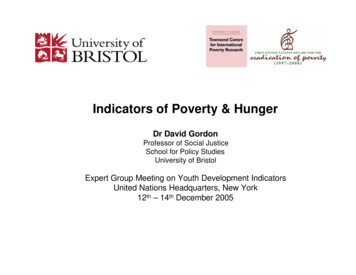
Transcription
Indicators of Poverty & HungerDr David GordonProfessor of Social JusticeSchool for Policy StudiesUniversity of BristolExpert Group Meeting on Youth Development IndicatorsUnited Nations Headquarters, New York12th – 14th December 2005
Indicators of Poverty for YouthMDG Target: Halve, between 1990 and 2015, the proportion of peoplewhose income is less than one dollar a dayMDG Indicators1) Proportion of population below 1 (1993 PPP) per day2) Poverty gap ratio [incidence x depth of poverty]3) Share of poorest quintile in national consumption
Absolute and Overall PovertyAfter the World Summit on Social Development in Copenhagen in 1995, 117 countriesadopted a declaration and programme of action which included commitments to eradicate“absolute” and reduce “overall” poverty.Absolute poverty was defined as "a condition characterised by severe deprivation ofbasic human needs, including food, safe drinking water, sanitation facilities, health,shelter, education and information. It depends not only on income but also on access toservices."Overall poverty takes various forms, including "lack of income and productive resourcesto ensure sustainable livelihoods; hunger and malnutrition; ill health; limited or lack ofaccess to education and other basic services; increased morbidity and mortality fromillness; homelessness and inadequate housing; unsafe environments and socialdiscrimination and exclusion. It is also characterised by lack of participation in decisionmaking and in civil, social and cultural life. It occurs in all countries: as mass poverty inmany developing countries, pockets of poverty amid wealth in developed countries, loss oflivelihoods as a result of economic recession, sudden poverty as a result of disaster orconflict, the poverty of low-wage workers, and the utter destitution of people who falloutside family support systems, social institutions and safety nets. (UN, 1995)
UN Definition of Poverty“Fundamentally, poverty is a denial of choices and opportunities, aviolation of human dignity. It means lack of basic capacity to participateeffectively in society. It means not having enough to feed and cloth afamily, not having a school or clinic to go to, not having the land on whichto grow one’s food or a job to earn one’s living, not having access tocredit. It means insecurity, powerlessness and exclusion of individuals,households and communities. It means susceptibility to violence, and itoften implies living on marginal or fragile environments, without access toclean water or sanitation”(UN Statement, June 1998 – signed by the heads of all UN agencies)
Deprivation can be conceptualised as a continuum which ranges from no deprivationthrough mild, moderate and severe deprivation to extreme deprivation.Continuum of deprivationMildModerateSevereNo DeprivationExtreme DeprivationIn order to measure absolute poverty amongst children, it is necessary to definethe threshold measures of severe deprivation of basic human need for:1.2.3.4.foodsafe drinking watersanitation naccess to services
Proposed Operational Definitions of Severe Deprivation of Basic Human Need for Youth1) Severe Food Deprivation– Body Mass Index of 16 or below (severe underweight).2) Severe Water Deprivation - access only to surface water (e.g. rivers, ponds) for drinking orliving in households where the nearest source of water was more than 15 minutes away –30min round trip (e.g. indicators of severe deprivation of water quality or quantity).3) Severe Deprivation of Sanitation Facilities – no access to a toilet of any kind in the vicinityof their dwelling, e.g. no private or communal toilets or latrines.4) Severe Health Deprivation – Women who did not receive treatment for a recent seriousillness or who did not receive any antenatal care or who did not receive any assistance withbirth or who did not receive a tetanus inoculation during her pregnancy.Men who did not receive treatment for a recent serious illness.5) Severe Shelter Deprivation – living in dwellings with 4 or more people per room (severeovercrowding) or in a house with no flooring (e.g. a mud floor).6) Severe Education Deprivation – youth who never attended school and who are alsoilliterate7) Severe Information Deprivation – no access to newspapers, radio or television orcomputers or phones at home (e.g. no information sources).Absolute Poverty threshold is equal to 2 or more severe deprivations of basic human need
Proposed Operational Definitions of Deprivation of Basic Human Need for Youth1) Food Deprivation– Body Mass Index of 18.5 or below (underweight).2) Water Deprivation - access only to unimproved source such as open wells, open springs orsurface water or who have to walk for more than 15 minutes to their water source (30minutes round-trip).3) Deprivation of Sanitation Facilities – access only to unimproved sanitation facilities e.g. :pour flush latrines; covered pit latrines; open pit latrines; and buckets or no access to atoilet of any kind.4) Health Deprivation – Women who did not receive treatment for a recent serious illness orwho did not receive the minimum standard of antenatal care from a person trained inmidwifery or who do not know that a healthy person can transmit HIV/ AIDS or who donot know that using a condom during sex can prevent HIV/ AIDS transmission.Men who did not receive treatment for a recent serious illness or who do not know that ahealthy person can transmit HIV/ AIDS or that using a condom during sex can preventHIV/ AIDS transmission.5) Shelter Deprivation – living in dwellings with 3 or more people per room (overcrowding)or in a house with no flooring (e.g. a mud floor) or inadequate roofing (e.g. natural roofingmaterials)6) Education Deprivation – youth who did not complete primary school or who are illiterate7) Information Deprivation – no access to a radio or television (i.e. broadcast media) at home.The Poverty threshold is equal to 2 or more deprivations of basic human need
Countries with income, expenditure or deprivation survey data which areavailable for download via the World Wide Web
Indicators of Hunger for YouthMDG Target: Halve, between 1990 and 2015, the proportion of peoplewho suffer from hungerMDG Indicators1) Proportion of children under five years old who are underweight2) Proportion of population below minimum level of dietary energyconsumption (FAO)
Body Mass Index GroupsBMIWeight StatusUnder 16Severe underweight16-18.5Underweight20-25Normal weight25-30Overweight30-40Obese40 Very Obese
Indicators of Poverty for Youth MDG Target: Halve, between 1990 and 2015, the proportion o
